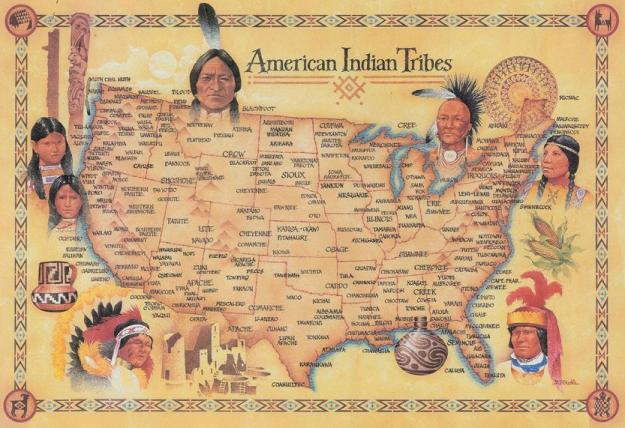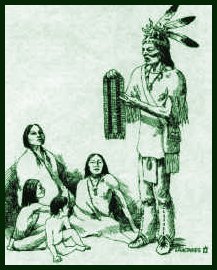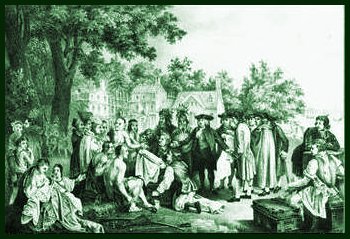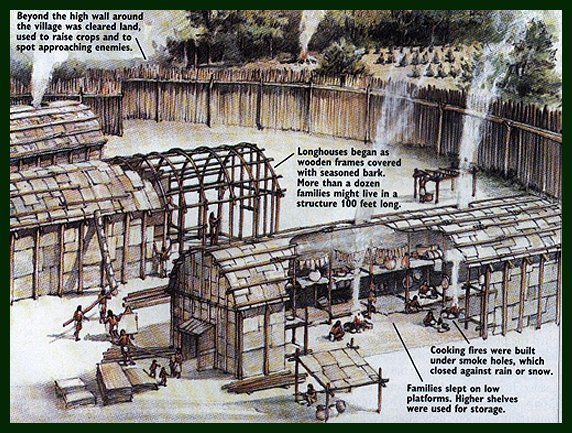Back to Book 7 / Home Page / Angélique Home Page
What Were the Five Nations of the Iroquois and Why Did They Unite?
The Five Nations of the Iroquois, also known as the Iroquois League, was a confederation of Native American tribes in the northeastern region of North America. This confederation, formed prior to widespread European colonization, was instrumental in the conflict between the French and English for control of large areas of North America.
The Tribes
The five tribes of the Five Nations of the Iroquois were the Cayuga, Mohawk, Oneida, Onondaga and Seneca. These tribes were spread over the northeastern region of North America in what is now upstate New York and lower Canada. The Tuscarora tribe joined in 1722, after European colonization had begun. The tribes referred to themselves as "Oñgwanon sioñni," which translates to "we are of the extended lodge," which represented the kinship between the tribes.

Unification
The unification of the Five Nations began sometime between 1570 and 1600 when a member of the Seneca tribe began negotiating a treaty with Hiawatha, a member of the Onondaga tribe who was living among the Mohawks. Gradually, the two other nations entered into a similar alliance with these tree tribes and a permanent bond was forged. Each tribe agreed that they would not come into conflict with one another as a matter of protection.
Structure
The Five Nations organized their executive duties through the use of councils, which had members of the chief class from each individual tribe. A central council made decisions that would be obeyed by all the tribes. The Five Nations outlined thoroughly how leaders should be picked, how business was to be conducted between the tribes, and installed a common code of ethics and rituals.
French-English Conflict
When the French explorer Samuel de Champlain first came to North America in what is now the eastern region of Canada, he initially aided Canadian Indians in an attack against the Iroquois League. The Iroquois procured firearms from the Dutch and fought back. After conflict began between the French and English in the French and Indian War (1754 to 1763), the Iroquois helped the English push the French back to modern-day Canada. When the founding fathers of America wrote the Constitution, they borrowed principles from the Five Nations, including the give-and-take relationship between the Senate and House of Representatives.
The Iroquois Confederacy (also known as the “League of Peace and Power”, the “Five Nations”; the “Six Nations”; or the “People of the Longhouse”) is a group of First Nations/Native Americans that originally consisted of five nations: the Mohawk, the Oneida, the Onondaga, the Cayuga, and the Seneca. A sixth tribe, the Tuscarora, joined after the original five nations were formed. Although frequently referred to as the Iroquois, the Nations refer to themselves collectively as Haudenosaunee in Tuscarora, Rotinonsionni in Mohawk.
Warfare was endemic among most prehistoric Woodland Indians. The Iroquois revered war, although from about 1500 on, give or take 50 years or so, it was reserved for non-natives and tribes outside of the Iroquois League. The ritual torture of captives was common. Some groups also engaged in cannibalism. Both of these activities were associated with sun sacrifice and may show Mesoamerican influences. Among many groups, captives were frequently adopted to make up for population losses.
Many Indians seem to have preferred taking their enemies prisoner rather than killing them. The seventeenth century Iroquois placed capture of prisoners above other war objectives as a means of maintaining population levels, which were under stress from disease and the new level of violence brought on by wars to control the fur trade. This concern with population shaped Iroquois military practice. Their warriors did not take unnecessary risks and were prepared to yield an apparent victory in the field if the cost in life was too high. The emphasis on “skulking war” was consistent with these concerns.
Samuel de Champlain, the French explorer, is asked by some Indians he is visiting (members of the Huron tribe), for help against their enemies, members of the formidable Iroquois confederacy. Champlain loads his gun, a long heavy device that bears no resemblance to the early hand cannons, with a charge of powder and three bullets. He joins the army of his new friends, and they confront the Iroquois army. Both armies consist of naked warriors armed with bows and arrows. Two of the Iroquois chiefs advance to challenge the Hurons. One of the chiefs lifts his bow. Champlain fires.
Both chiefs fall to the ground. The Iroquois flee.
Champlain’s shot, hitting two enemies at once, was probably the best the explorer ever made. It was also one of the most historic in North American history. It started the centuries-long hostility between the Iroquois and the French, a development that had the most profound effect on colonial North America.
Expeditions by the Patriots, such as John Sullivan’s campaign against the Iroquois in 1779, were often unsuccessful, in Sullivan’s case in large part because of the logistical problems facing expeditions deep into the interior, especially a lack of transport. Nevertheless, thanks to careful reconnaissance, Sullivan’s army was able to avoid ambush. The frontier war was a brutal exercise in no quarter, slash and burn tactics. The Iroquois visited Wyoming and Cherry Valley with the flame and tomahawk, and Sullivan returned the loan with interest.

A powerful alliance of several Iroquoian-speaking tribes in northeastern North America The Iroquois Confederacy, or Iroquois League, was originally a union of five tribes—SENECA, MOHAWK, CAYUGA, ONEIDA, and ONONDAGA. They occupied what is today upper New York State and the Lake Ontario region of Canada. In the early 1700s, a sixth tribe, the TUSCARORA (who migrated from North Carolina), joined the confederacy.
According to legend, HURON prophet Deganawidah, the supernatural benefactor of the Iroquois, grieved because the Iroquois tribes were fighting among themselves. This left the Iroquois vulnerable to their enemies. Deganawidah chose Hiawatha, a Mohawk chief, to build a union among five of the Iroquois-speaking tribes. The alliance was in place by the late 1500s, sometime before Europeans arrived in their territory.
The tribes met regularly in a “great council” to discuss and make decisions on issues crucial to all. Women of each tribe  chose the sachems, or chiefs, who served on this 50-member council. The council governed the confederacy and dealt with matters of intertribal war, peace, and diplomacy. The confederacy had no voice in the affairs of the individual tribes except to act as a mediator in internal disputes.
chose the sachems, or chiefs, who served on this 50-member council. The council governed the confederacy and dealt with matters of intertribal war, peace, and diplomacy. The confederacy had no voice in the affairs of the individual tribes except to act as a mediator in internal disputes.
In the early 1600s, the Dutch in New Netherlands employed the Iroquois in the fur trade, furnishing them with guns and ammunition in exchange for furs. Armed and skilful warriors, the Iroquois soon became one of the most powerful Indian military forces in colonial America and quickly subjugated surrounding tribes. The Iroquois had poor relations with the French, who had established a fur-trading alliance with the Iroquois’s traditional enemies, the Huron. The Huron persuaded French explorers Samuel de Champlain to wage war against Iroquois groups in the Saint Lawrence valley region. From that time the Iroquois Confederacy were inveterate enemies of the French. The heavily armed Iroquois frequently raided French settlements and attacked the Indian allies of the French, persisting in their efforts until they had wrested control of the Huron fur trade. Moreover, the Iroquois’s formidable presence successfully blocked the southward expansion of the French, who were forced to divert their trade westward. In 1664, the English took control of the Dutch colony of New Netherlands, renamed it New York, and included the Iroquois Confederacy within their fur-trading networks. Around 1713, the Tuscarora joined their kinsmen in the Confederacy (thereafter known as the Six Nations); they had left their homeland in the Carolinas following devastating attacks on them by colonial and Indian forces from the YAMASEE, CHEROKEE, and other southern tribes (see TUSCARORA WAR, 1711–13).
During the FRENCH AND INDIAN WAR (1754–63), the Iroquois League fought on the side of the British. They maintained this alliance until the Seneca joined with the pro-French OTTAWA Chief PONTIAC during PONTIAC’S REBELLION (1763–64). The British, eager to regain their loyalty, successfully reincorporated the Seneca after Pontiac’s defeat.
 At the beginning of the AMERICAN REVOLUTION (1775–81), the British advised the Iroquois Confederacy to remain neutral. Before long, however, both the British and Americans were trying to recruit the Indians. Divided loyalties soon split the Confederacy, and the Tuscarora, Oneida, and a small number of Mohawk sided with the colonists, while the Seneca, Onondaga, Cayuga, and most of the Mohawk fought on the side of the British. The Confederacy irreparably broke when brother fought against brother at the battle of ORISKANY CREEK (1877) in Upper New York.
At the beginning of the AMERICAN REVOLUTION (1775–81), the British advised the Iroquois Confederacy to remain neutral. Before long, however, both the British and Americans were trying to recruit the Indians. Divided loyalties soon split the Confederacy, and the Tuscarora, Oneida, and a small number of Mohawk sided with the colonists, while the Seneca, Onondaga, Cayuga, and most of the Mohawk fought on the side of the British. The Confederacy irreparably broke when brother fought against brother at the battle of ORISKANY CREEK (1877) in Upper New York.
During 1788 and 1789, a combined force of British led by Colonel John Butler and Iroquois forces led by Mohawk Thayendanegea, known by the British as JOSEPH BRANT, attacked outlying New York settlements. General GEORGE WASHINGTON sent General JOHN SULLIVAN to retaliate. He fought a pitched battle with part of the confederacy and their British allies near Elmira, New York. He then marched through the large Seneca towns, destroying houses, orchards, and everything in his path. Many Indians thus went without food and shelter that winter, and hundreds died. The consequent split ultimately broke the confederacy as a formidable military force. (It remained, however, as a focal point of Iroquois culture, and still remains so today.) At the end of the American Revolution, significant numbers of Iroquois moved to Canada. The major portion, however, live today on various reservations in New York State.

The Iroquois (pronounced /ˈɪrəkwɔɪ/), also known as the Haudenosaunee or the "People of the Longhouse",are an association of several tribes of indigenous people of North America. After the Iroquoian-speaking peoples coalesced as distinct tribes, based mostly in present-day central and upstate New York, in the 16th century or earlier they came together in an association known today as the Iroquois League, or the "League of Peace and Power". The original Iroquois League was often known as the Five Nations, as it was composed of the Mohawk, Oneida, Onondaga, Cayuga and Seneca nations. After the Tuscarora nation joined the League in 1722, the Iroquois became known as the Six Nations. The League is embodied in the Grand Council, an assembly of fifty hereditary sachems.

Image courtesy of Scarborough K12
The Iroquois refer to themselves as the "Haudenosaunee", which means "People of the Longhouse," or more accurately, "They Are Building a Long House." According to their tradition, The Great Peacemaker introduced the name at the time of the formation of the League. It implies that the nations of the League should live together as families in the same longhouse. Symbolically, the Mohawk were the guardians of the eastern door, as they were located in the east closest to the Hudson, and the Seneca were the guardians of the western door of the "tribal longhouse", the territory they controlled in New York. The Onondaga, whose homeland was in the centre of Haudenosaunee territory, were keepers of the League's (both literal and figurative) central flame. The French colonists called the Haudenosaunee by the name of Iroquois. The name had several possible origins:
French transliteration of irinakhoiw, a Huron (Wyandot) name for the Haudenosaunee. Used in a derogatory way, it meant "black snakes" or "real adders". The Haudenosaunee and Huron were traditional enemies, as the Huron were allied with the French and tried to protect their access to fur traders.
French linguists, such as Henriette Walter, and anthropologists, such as Dean Snow, support the following explanation. Prior to French colonization, Basque fishermen traded with the Algonquins, who were enemies of the Haudenosaunee. The above scholars think "Iroquois" was derived from a Basque expression, hilokoa, meaning the "killer people". Because there is no "L" sound in the Algonquian languages of the Gulf of Saint Lawrence region, the Algonquian tribes used the name Hirokoa for the Haudenosaunee. They applied this to the pidgin language which they used with the Basque. The French transliterated the word according to their own phonetic rules and arrived at "Iroquois".
In the early 17th century, the Iroquois were at the height of their power, with a population of about twelve thousand people. In 1654, they invited the French to establish a trading and missionary settlement at Onondaga (in present-day New York state). The following year, the Mohawk attacked and expelled the French from this trading post, possibly because of the sudden death of 500 Indians from an epidemic of smallpox, a European infectious disease to which they had no immunity.
From 1658 to 1663, the Iroquois were at war with the Susquehannock and their Delaware and Province of Maryland allies. In 1663, a large Iroquois invasion force was defeated at the Susquehannock main fort. In 1663, the Iroquois were at war with the Sokoki tribe of the upper Connecticut River. Smallpox struck again; and through the effects of disease, famine and war, the Iroquois were threatened by extermination. In 1664, an Oneida party struck at allies of the Susquehannock on Chesapeake Bay.
In 1665, three of the Five Nations made peace with the French. The following year, the Canadian Governor sent the Carignan regiment under Marquis de Tracy to confront the Mohawks and the Oneida. The Mohawks avoided battle, and the French burned their villages and crops. In 1667, the remaining two Nations signed a peace treaty with the French. This treaty lasted for 17 years.
Many links to the information on this page are now defunct and as such I am unable to offer a reference point / link.
Return to Top / Angélique Home Page / Home Page
Page refreshed : 9th January 2017
